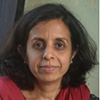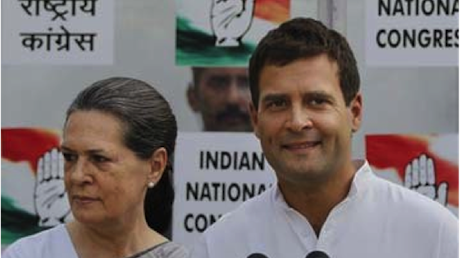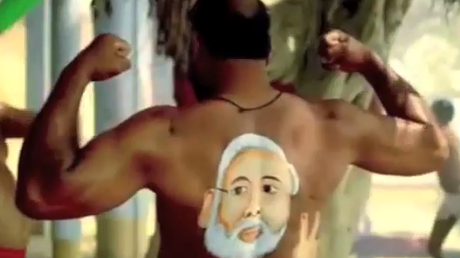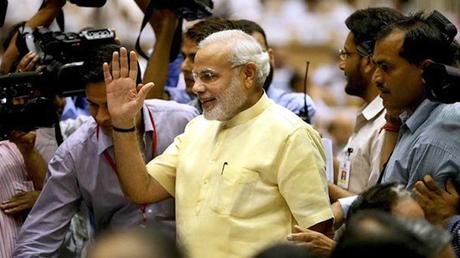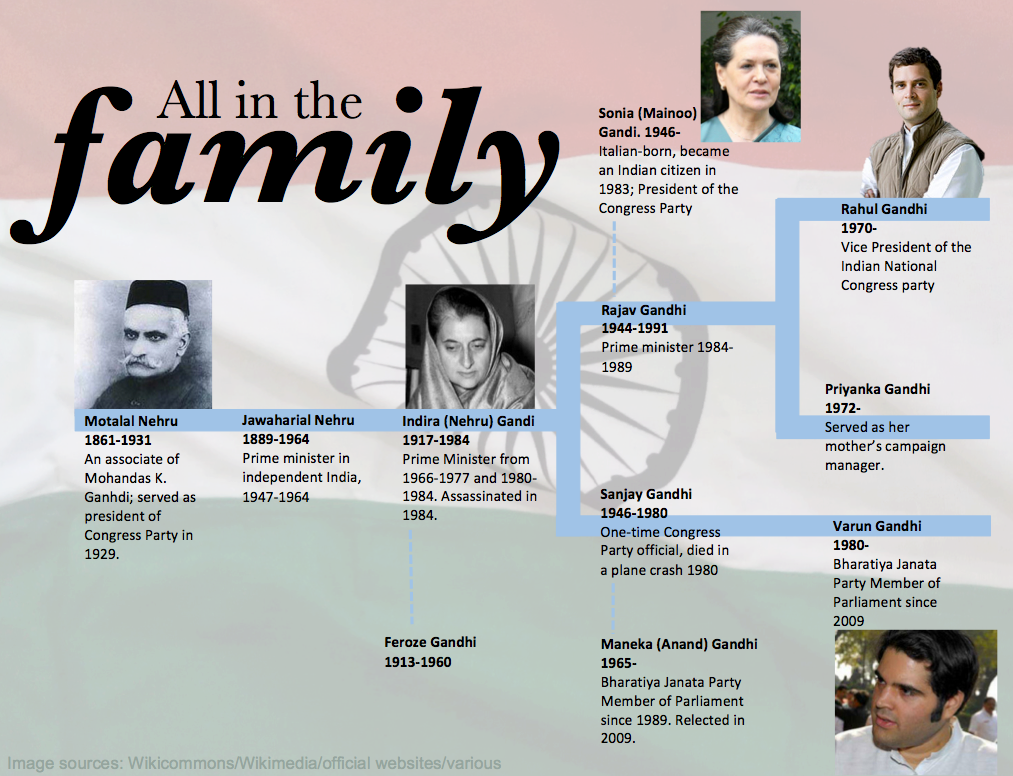
India is celebrated as the largest democracy in the world, but it is also home to dynastic political leadership befitting a monarchy. Politicians face elections every five years, but the family connections of many elected representatives ensure they are shoo-ins in the race for party tickets - except when two families vie for the party ticket in the same constituency. Much like family heirlooms, constituencies are passed on from father to son (and daughter).
In his book India: A Portrait, Patrick French showed by statistical analysis (read excerpt here) that every member of parliament under 30 in the outgoing Lok Sabha inherited his or her constituency, and over two-thirds of 66 MPs aged 40 and under had done so.
Dynasty’s most famous face is of course Rahul Gandhi, scion of the Nehru-Gandhi family who is leading the Congress party’s election campaign. His father was a Prime Minister, as was his mother and his grandfather.
The problem, of course, is that dynastic leadership does not encourage challengers. That in turn ensures a self-fulfilling prophesy: there is no alternative. With an abundance of sycophants in the party, a non-Nehru-Gandhi aspirant can put his hand up only at great risk to his own future.
Through the years immediately following the 1991 assassination of Rahul’s father Rajiv, the “first family” of the Congress - as the Gandhis are known - kept out of politics but did not snap their links to the party and continued to wield influence over it through trusted retainers. Unsurprisingly, speculation would erupt every now and then that Rajiv’s Italian-born wife Sonia Gandhi was about to take the plunge into politics.
She eventually did, taking over the reins of the party in 1998 at the pleading of its members after that year’s election rout. The first test of her leadership came just a year later when the sitting BJP Government fell in 1999 and a snap election was called. It proved to be the Congress’s worst, but it was still not bad enough for the party to lose hope in the family; later, her leadership in the victorious 2004 campaign cemented her hold over the party.
In a decision that was praised across the world as an act of sacrifice, Sonia declined to take charge as Prime Minister. She nominated instead Manmohan Singh, a self-effacing economist who was the finance minister in the 1991-96 Congress government. The move also pre-empted any criticism that the country had been handed over to a “foreigner”. But as the head of the party, Sonia was seen as the real power centre. Few doubted the baton would eventually pass to either her son Rahul, or her daughter Priyanka.
Despite misgivings about fresh-faced Rahul’s political acumen, his apparent lack of confidence and his semi-reluctant style of leadership, Congress members have convinced themselves that only a Nehru-Gandhi can lead the party. The party also embraces him as more representative of the changing demography of the country – nearly 40 per cent of India’s population is now in the 15-34 age group – even though 43-year-old Rahul would be counted as middle-aged anywhere else.
The problem, of course, is that dynastic leadership does not encourage challengers. That in turn ensures a self-fulfilling prophesy: there is no alternative. With an abundance of sycophants in the party, a non-Nehru-Gandhi aspirant can put his hand up only at great risk to his own future.
The Congress is certainly not the only party that depends on dynasty. As the nomination process has shown in many of India’s 543 constituencies, most parties would rather bet on politically influential families than on new faces. Sons and daughters of politicians see nothing wrong with capitalizing on the advantage of a family push to their own political careers. From their point of view, if they are elected through a popular vote, that pretty much settles the debate.
In Rahul Gandhi’s case the supreme irony is his constant refrain that he wants to “democratise” the party. Sadly, he has given no indication yet that this applies to the top leadership. In a break from the non-transparent tradition of a chosen few deciding on nominations behind closed doors , the party did hold primaries to select candidates for this campaign. But in a sign of how deep dynasty runs at all levels, the results were uneven
The Congress is widely predicted to be facing electoral rout this time, and if the polls are to be believed, perhaps a performance even worse than in 1999. In western democracies the leader of the losing party usually quits, making way for a change at the top. The million-dollar question about the Congress if it is defeated is whether this will finally prompt the party to look beyond family for leadership.
The extraordinary success of the middle class-representing Aam Aadmi Party in the December 2013 elections to the provincial government in Delhi showed that an ordinary Joe like Arvind Kejriwal, a political unknown until two years ago, can succeed simply because he is seen as more representative of the people than traditional political elites.
A driver of that shift was the outpouring of voter rage against Congress and its corrupt politicians. Weighed down by cliques and gatekeepers who control access to the family, the party’s present leadership is seen as unable to keep in touch with the aspirations of influential segments of the country’s voters – an assertive middle class and youth. For instance, when young people came out in their thousands to protest the rape of a girl in a Delhi bus in the winter of 2012, no Congress leader (or for that matter, no leader from any other party) immediately stepped up to express solidarity with them. With Rahul Gandhi apparently reluctant to face the protests other party leaders, including the large group of the party’s young parliamentarians, were hesitant to do so for fear of attracting the criticism that they were getting above themselves.
Supporters of the 130-year-old party, who see it as a progressive alternative to the right-wing Hindutva Bharatiya Janata Party, would want the Congress to reinvent itself even to play its role as an opposition party. Commentators have said the first step the party must take to prevent self-destruction is to hold internal elections and hand over the reins to a democratically chosen leadership.
The tragedy is that when Congress members speak of an alternative, they speak of Rahul’s sister Priyanka. She is said to the more politically astute and charismatic of the two siblings, and as an added bonus resembles her grandmother Indira. Burdened by a corruption-tainted husband she has seemed keener to devote her life to bringing up her children. But it would be surprising if there isn’t a clamour for her to step in and save the party.
For the record, most democracies in South Asia have been ruled by dynasties at one time or the other. Sri Lanka was the first to set off the trend with the Bandaranaikes. That family also holds the record for being the only one in the region to quit politics after a challenger took over the party it had founded. In an irony of sorts, the challenger now seems unshakeable, and has a dynasty of his own.


